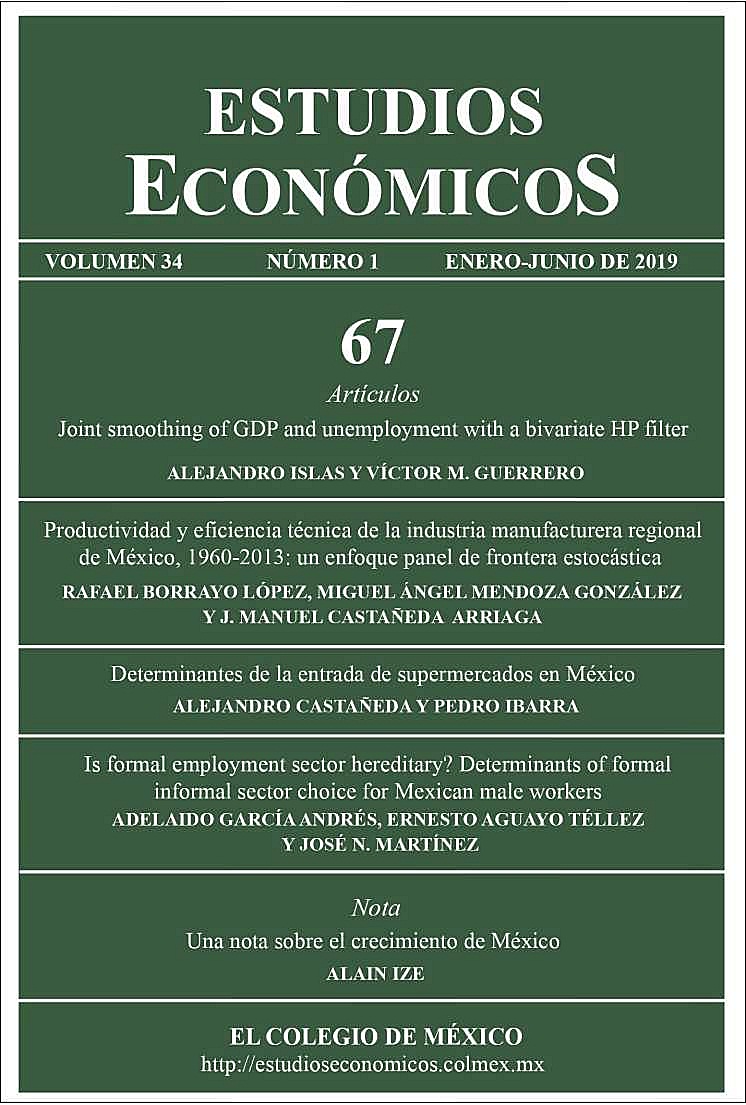Artículos
Suavizamiento conjunto del PIB y la tasa de desempleo con un filtro HP bivariado
Publicado 2019-01-01
Palabras clave
- ciclo de negocios,
- correlación,
- desempleo cíclico,
- extracción de señal,
- índice de suavidad
Cómo citar
Islas, A., & Guerrero, V. M. (2019). Suavizamiento conjunto del PIB y la tasa de desempleo con un filtro HP bivariado. Estudios Económicos De El Colegio De México, 34(1), 3–24. https://doi.org/10.24201/ee.v34i1.362
Resumen
Se considera el problema de estimar conjuntamente las tendencias y los ciclos no observables de una serie de tiempo bivariada, en el contexto macroeconómico de la Ley de Okun, para relacionar las brechas del producto y la tasa de desempleo. La estimación se realiza con un filtro de Hodrick-Prescott bivariado que estima simultáneamente la correlación entre los ciclos. La contribución principal de este enfoque es que se puede controlar la suavidad de las tendencias al fijar un parámetro de suavizamiento en forma apropiada. La ilustración empírica utiliza datos del PIB y de la tasa de desempleo de Estados Unidos.
Descargas
Los datos de descargas todavía no están disponibles.
Citas
- Adams, C. and D.T. Coe. 1990. A systems approach to estimating the natural rate of unemployment and potential output for the United States, IMF Staff Papers, 37: 232-293.
- Blanchard, O.J. and D. Quah, 1989. The dynamic effects of aggregate demand and supply disturbances, The American Economic Review, 79(4): 655-673.
- Boone, L. 2000. Comparing semi-structural methods to estimate unobserved variables: The HPMV and Kalman filters approaches, OECD Economics Department Working Papers, no. 240.
- Chagny, O. and M. Lemoine, 2002. The impact of the macroeconomic hypothesison the estimation of the output gap using a multivariate Hodrick-Prescott filter: The case of the Euro area, Eurostat Colloquium on Modern Tools for Business Cycle Analysis.
- Clark, P. K. 1987. The cyclical component of U.S. economic activity, The Quarterly Journal of Economics, 102: 797-814.
- Clark, P. K. 1989. Trend reversion in real output and unemployment, Journal of Econometrics , 40: 15-32, DOI: 10.1016/0304-4076(89)90027-4.
- Dermoune, A., B. Djehiche, and N. Rahmania. 2009. Multivariate extension of the Hodrick-Prescott Filter-Optimality and characterization, Studies in Nonlinear Dynamics & Econometrics, 13(3): 1-33.
- Dupasquier, C., A. Guay, and P. St-Amant. 1999. A survey of alternative methodologies for estimating potential output and the output gap, Journal of Macroeconomics, 21(3): 577-595.
- Evans, G.W. 1989. Output and unemployment dynamics in the United States: 1950-1985, Journal of Applied Econometrics, 4(3): 213-237, DOI:10.1002/jae.3950040302.
- Federal Reserve Bank of St. Louis. 2006. FRED II (Federal Reserve Economic Data), <https://fred.stlouisfed.org/>;.
- Ford, R. and D.E. Rose. 1989. Estimates of the NAIRU using an extended Okun’s Law, Working Paper, no. 89-3, Bank of Canada.
- Gómez, V. 1999. Three equivalent methods for filtering finite nonstationary time series, Journal of Business and Economic Statistics, 17: 109-166.
- Grant, A.P. 2002. Time-varying estimates of the natural rate of unemployment: A revisitation of Okun’s Law, The Quarterly Review of Economics and Finance, 42(1): 95-113, DOI: 10.1016/S106297-69(01)00109-0.
- Guerrero, V. M. 2007. Time series smoothing by penalized least squares, Statistics and Probability Letters, 77: 1225-1234, DOI: 10.1016/j.spl.2007.03.006.
- Guerrero, V. M. 2008. Estimating trends with percentage of smoothness chosen by the user, International Statistical Review, 76(2): 187-202, DOI: 10.1111/j.1751-5823.2008.00047.x.
- Guerrero, V. M., C.A. Islas, and R.L. Ramirez. 2017. Trend estimation of multivariate time series with controlled smoothness, Communications in Statistics-Theory and Methods, 46(13): 6704-6726, DOI: 10.1080/03610926.2015.1133826.
- Hodrick, R.J. and E.C. Prescott. 1997. Postwar U.S. business cycles: An empirical investigation, Journal of Money Credit and Banking, 29: 1-16.
- Kydland, F.E. and E.C. Prescott. 1982. Time to build and aggregate fluctuations, Econometrica, 50(6): 1345-1370.
- Laxton, D. and R. Tetlow. 1992. A simple multivariate filter for the measurement of potential output, Technical Report no. 59, Bank of Canada.
- Morley, J.C., C.R. Nelson, and E. Zivot. 2003. Why are the Beveridge-Nelson and unobserved components decompositions of GDP so different? The Review of Economics and Statistics, 85(2): 235-243.
- Nelson, C. R. 1988. Spurious trend and cycle in the state decomposition of a time series with a unit root, Journal of Economic Dynamics and Control, 12(2/3): 475-488.
- Nelson, C. R., and C.I. Plosser. 1982. Trends and random walks in macroeconomic time series: Some evidence and implications, Journal of Monetary Economics, 10: 139-162.
- Okun, A.M. 1962. Potential GNP: Its measurement and significance, American Statistical Association, Proceedings of the Business and Economic Statistics Section, 98-104.
- Prachowny, M.F.J. 1993. Okun’s law: Theoretical foundations and revised estimates, Review of Economics and Statistics, 75: 331-336, DOI: 10.2307/2109440.
- Prescott, E.C. 1987. Theory ahead of business cycle measurement, Carnegie Rochester Conference Series on Public Policy, 25: 11-44.
- Sinclair, T.M. 2009. The relationship between permanent and transitory movements in U.S. output and the unemployment rate, Journal of Money, Credit and Banking, 41(2-3): 529-542.
- Stock, J.H. and M.W. Watson. 1988. Variable trends in economic time series, Journal of Economic Perspectives, 2: 147-174.
- Theil, H. 1963. On the use of incomplete prior information in regression analysis, Journal of the American Statistical Association, 58: 401-414, DOI:10.2307/2283275.
- US Department of Commerce. 2004. Bureau of Economic Analysis (BEA).<http://www.bea.doc.gov/bea/dn/home/gdp.htm.>;

